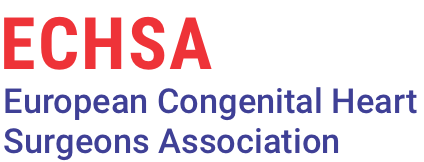287276333

"...One of our responsibilities as physicians caring for patients with Congenital Heart Disease is to know the results of the treatment that we recommend..."
W.G.Williams
Visit the ECHSA Congenital Database Website here
The initial aim of collecting data on the outcomes of Congenital Heart Surgery procedures across Europe was to make possible comparison of results and definition of mortality and morbidity, risk factors as well as targeting research activities. This requires good quality data obtained on a large scale from numerous congenital surgical cardiothoracic units primarily from Europe (but also from other parts of the world) as well as data validation and verification.Such data collection should allow risk stratification and help define optimal surgical treatment for certain subsets of patients exposed to incremental mortality and morbidity risk factors.
It is hoped that study of the wealth of information collected in the Database will also result in improved early and late survival as well as in enhanced quality of life of surgically treated patients with Congenital Heart Disease across Europe and the world.
Further goal of data collection is to enable predictive statistical analysis and comparison of results according to pathologies and procedures from various centers and countries, which will help to define official European standards available for health care organizations, legal assistance, and public information.
The European Congenital Heart Surgeons Foundation, which was established in 1992 and renamed as the European Congenital Heart Surgeons Association (ECHSA) in 2003, created the European Congenital Heart Defects Database (ECHDD), precursor of today’s ECHSA Congenital Database.
The ECHDD was supervised by Martin Elliott and based at the Great Ormond Street Hospital For Sick Children, London, UK.
In 2000, the ECHDD was moved, for legal and logistical reasons, to the Department of Cardiothoracic Surgery, Children’s Memorial Health Institute, Warsaw, Poland under the responsibility of Bohdan Maruszewski.
Simultaneously, since 1994, a substantial amount of work was done within the European Association for Cardio-Thoracic Surgery (EACTS) on establishing the EACTS Database named European Cardiothoracic Surgical Registry (ECSUR).
In September 1999, during the EACTS Annual Meeting in Glasgow, a decision was made that ECHDD would become a part of the EACTS Database Project under the new name EACTS Congenital Database. In the same time, an International Nomenclature for Congenital Heart Surgery was officially adopted; this was the outcome of one year’s work of the International Nomenclature and Database Committees for Congenital Heart Disease of both EACTS and the Society of Thoracic Surgeons (STS) in the USA.
Over the course of eight meetings at several venues on both sides of the Atlantic, in 1998 and 1999, an International Nomenclature and Database Committee met with 36 experts from the membership of the EACTS, STS, AATS, AHA associated surgeons and cardiologists from the United States, Canada, Australia and Europe.
These efforts resulted in the creation of the International Nomenclature for Congenital Heart Surgery, including the Minimum Data Set and the lists of Diagnoses, Procedures, Complications, as well as extra cardiac anomalies and preoperative risk factors encoded in the Database.
This International Language for CHD fulfills the following expectations and requirements:
- simple, limited and exclusive
- complete
- usable by surgeons and cardiologists
- includes congenital heart surgery, lung surgery, ECMO and arrhythmia procedures
- respects published classifications
- provides synonyms for similar items.
In 2015, for legal and financial reasons, the Database, which has always been owned by ECHSA and seated in Warsaw since 2000, reverted back to exclusive management by ECHSA under the name ECHSA Congenital Database, and under the responsibility of the ECHSA Database Committee.
The ECHSA Database Committee’s leadership includes the Chair, the Director, and the Technical Director, as well as other ECHSA Members and representatives of the STS National Database and other Scientific Associations.
During the recently completed very successful tenure of the Committee’s first Chair, Prof. Tjark Ebels, the Database has been translated to many languages and has achieved a truly global outlook. Professor Bohdan Maruszewski, who has served as the Database Director from the beginning, has now also assumed the Chairmanship of the Committee, continuing the remarkable efforts of Database development with new user – friendly and extremely powerful online tools, international cooperation initiatives, and production of major scientific publications, all supported at the Database’s seat in Warsaw, under the continued information technology support of Dr Zdzislaw Tobota, the Technical director. The Database Committee also includes selected ECHSA Members as well as representatives of other Scientific Societies, notably the STS National Database, represented by Dr. Jeff Jacobs. In fact, in cooperation with the STS Congenital Database, many landmark publications have been produced, and more are underway.
It should be emphasized that the Database is supported by ECHSA to serve its Members and its Data Contributors, to which ECHSA is more than grateful. The Data, resources, and facilities of the Database are available to use to achieve worthy clinical research projects which may be proposed by any Member, an activity which is highly recommended and encouraged by ECHSA! You can find the detailed ECHSA Congenital Database Charter at this link.
General Rules Of The ECHSA Congenital Database
Access to the Database - software, continued support and reports – is available via Internet for all cardiothoracic units in Europe and worldwide, for a symbolic yearly participation fee which has been necessary to support the Database activities and development.Strict attention to data confidentiality in compliance with all current rules governs the function of the Database. No personal data contained in the ECHSA Congenital Database is accessible by an individual or institution. Only surgeons and centers know their own identity codes and those of their patients. Patient’s personal data are not transmitted at all, and patient identification can be replaced with another number at the Center of origin, before transmission of data to the Database.


 +30 210 6847700
+30 210 6847700